Mango insect pests and their integrated management strategies
Plant protection research is focused on integrating new tools and technologies into IPM in horticulture. The fruit sector in India recorded a growth of around 16% last year, compared to 12% for vegetables and 10.8% for food grains. When used in conjunction with other pest control measures, plant protection research in horticulture has produced many technologies, some of which have been standardized for commercial application and are claimed to provide better pest control and crop economics than conventional chemical control. Nonetheless, due to a variety of technological, socio-economic, institutional, and policy factors, the development and adoption of many of these technologies have been slow. owing to the complexity of biotic stress in horticulture under changing climatic scenarios, technology generation, and other factors, testing and adoption remain a significant challenge, particularly given the constraints and limited ability of smallholding farmers. There have been overlapping IPM approaches in India, such as the traditional, exploitive/maximization phase, optimization phase, sustainable phase, and organic methods.
FARMERS in the green revolution era are frequently overly ambitious in their efforts to achieve rapid plant protection results on their farms, resulting in the overuse and misuse of pesticides, which poses significant risks because they are carried out with only an immediate profit or production motive. Many concerns have emerged as a consequence of this, including excessive and untimely use of natural resources, insecticide resistance, pest resurgence, pest control failures, environmental and ecological imbalances, reduced biodiversity, and inappropriate input use. This article provides a brief overview of mango pests.
Almost a dozen insect pests have been noticed damaging the crop to a significant extent, causing severe losses, and may thus be classified as major pests of mango. The hopper, mealybug, inflorescence midge, fruit fly, scale insect, shoot borer, leaf Webber, and stone weevil are among them. Insects that infest the crop during the flowering and fruiting periods cause the most severe damage.
Hopper (Idioscopus clypealis, I. nitidulus and Amritodus atkinsoni)
The hoppers are the most damaging and prevalent of all mango pests. The tender plant parts are punctured and sucked into the sap by a large number of nymphs and adult hoppers. This affects the vigour of the plants. Hoppers also secrete a sticky, sweet substance that promotes the growth of sooty mold. Throughout the year, there is a low population of hoppers, but it spikes in February-April and June-August. Their multiplication is aided by the presence of shade and high humidity. Such conditions are common in orchards that are old, neglected, and densely planted.
IPM strategy
- Prune, avoid high-density planting, and regulate flushes by reducing input.
- Verticillium lecanii, Beauveria bassiana, Coccinellid beetles, spiders, reduviid keep the hopper population in check.
- raying of Lamda cyhalothrin 0.0025% in mango orchards during the off-season (November), especially on the trunks.
- Integrating chemical insecticides with neem products depending on hopper density. The first spray should be given at early panicle emergence with the following.
(i) At high hopper density (>4 hoppers/panicle), spray Imidachloprid 0.005% or Lamda cyhalothrin 0.0025%
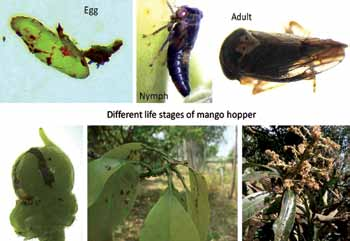
Mealy bug (Drosicha mangiferae)
It is a serious pest that plays havoc on mango trees. The sap is sucked by nymphs and adults, lowering the plant’s vitality. Honeydew is produced by them, which promotes the growth of sooty mold. After copulation, the female crawls down the tree in April-May to deposit eggs in great numbers covered with white egg sacs in the crevices in the soil. Until November or December, the eggs are in the diapause stage in the soil. The tiny newly hatched nymphs climb up the tree shortly after hatching. They begin sucking the sap of delicate plant parts after crawling up the tree.
IPM strategy
- Polythene (400 gauge) bands of 25 cm width around the tree trunk in November and December have been found to be an effective barrier to stop the ascent of nymphs to the trees.
- The entomogenous fungus Beauveria bassiana has been found to be an effective bio-agent in controlling the nymphs of the mealybug.
- The flooding of orchards with water in October kills the eggs and ploughing the orchards in November exposes the eggs to the sun’s heat.
- If nymphs ascend on the tree, spray malathion 50 EC (0.075 %).
Inflorescence midge (Procontarinia mangiferae and Erosomyia indica Grover)
The midge damages crops in three stages. The first attack occurs when the floral buds burst, followed by fruit set and tender new leaves. The most destructive attack is the first, which destroys the entire inflorescence before flowering and fruiting. The flies deposit their eggs on the inflorescence. The minute maggots penetrate the tender parts and feed on them after hatching. The floral parts eventually dry and fall off. Pupation occurs when the mature larvae drop down into the soil. Between January and March, there are three to four overlapping generations of the pest. When the weather becomes unfavourable, the mature larvae go into diapause in the soil rather than pupating. They end their diapause in January of the following year.
IPM strategy
- Because the larvae pupate in the soil, ploughing the orchards exposes both pupating and diapausing larvae to the sun’s heat, killing them.
- Spraying of 0.045% Dimethoate at the bud burst stage of the inflorescence has been found effective in controlling the pest population.
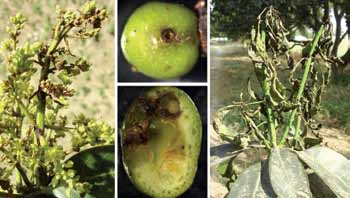
Fruit flies (Bactrocera dorsalis Hendel and B. zonata)
The oriental fruit fly is one of the most serious pests of mango in the country, causing problems with fresh fruit exports. The most common fruit flies are Bactrocera dorsalis and B. zonata. The female uses its pointed ovipositor to puncture the outer wall of mature fruits and insert eggs in small clusters inside the mesocarp of maturing fruits. After hatching, the larva feeds on the pulp of the fruit, which appears normal from the outside but eventually drops down. The mature maggots drop into the soil to pupate. The emergence of fruit flies begins in April, with the highest population recorded between May and July, which coincides with fruit maturity.
IPM strategy
- The soil is raked around and below the trees to a depth of 6 cm twice – Two weeks after the fruit reaches maturity and three weeks later.
- Ploughing may be done in the winter.
- Collection and destruction of fallen fruits weekly starting from the initiation of fruit maturity
- Male Annihilation Technique (MAT) @ 10 blocks /ha starting from 45 days before fruit maturity. Replace the blocks after 30 days or even early.
- Bait Annihilation Technique (BAT) (0.1% insecticide, 10% jaggery or banana in water) starting 45 days before fruit maturity. Spray in spots of 40 ml at a rate of 200 spots (approximately 8 l/ha). Apply bait spray in spots to surroundings hedges also.
- One spray of Deltamehtrin 0.0014% + Azadirachtin (3000 ppm) @ 2ml/l three weeks before harvest.
- Avoid delays in harvesting and, if needed, give post- harvest hot water treatment within 24 hours after harvest.
CISH OMAT fruit fly trap: The technology is meant for fruit fly trapping. About 4.5×4.5×1.2 cm wood killing block impregnated with methyl eugenol and killing mixture, fitted in water/ rainproof trap container of 1,100 ml capacity. It remains effective for 60-90 days depending on season.
Hot water treatment or salt water treatment (VHT): This procedure for fruits before storage and ripening to kill the larvae. After proper harvesting, select uniform-sized, undamaged fruits. Dip them in a 5% solution of sodium chloride in cold water for one hour. This will kill 95% of the eggs in the fruit epicarp and also remove the externally present pesticide residues. Post-harvest immersion of mango fruits in hot water at 48 ± 10C for 45-60 minutes gives 100% mortality of fruit fly eggs in the epicarp without affecting the fruit quality.

Scale insects
Scale insects have assumed the status of a serious pest in certain parts of the country. Pulvinaria polygonata, Aspidiatus destructor, Ceroplastis sp. and Rastococus sp. are some of the most common scale insects infesting the mango crop. The nymphs and adult scales suck the sap of the leaves and other tender parts and reduce the vigour of the plants. They also secrete honeydew, which promotes the growth of sooty mold.
IPM strategy
- Pruning of infested branches and burning.
- Around 40 species of predators and parasites have been reported to attack the scale.
- Chemicals used on scales that are usually used include dimethoate (0.05%) and malathion (0.075%).
- Sprays are only effective on the crawler stage of the scales.
- Control is difficult in other life stages.
- Adults are firmly attached to the plant and remain so after their death. That may give a false impression of the pest’s status. The application of pesticides may kill natural enemies of the scale and result in a resurgence of the pest.

Bark-eating caterpillar
This pest is more likely to attack old, shady, and neglected orchards. Larvae of this moth feed on the bark. The caterpillar spins a brown silken web on the tree which consists of its excreta and wood particles. Larvae also make shelter tunnels inside the stem in which they rest. Larvae feed from April to December. There is only one generation in a year.
IPM strategy
- The caterpillars can be killed by inserting an iron spike into the tunnels.
- Remove the webs from tree trunks and put an emulsion of malathion 50 EC (0.05%) in each hole and plug them with mud.
- Mix malathion 50 EC (0.05%) per liter of water and apply it to the bark-eating caterpillar-infested area with a brush at 15 days intervals.
- As a preventive measure, spraying of the attacked trunk and branches with 0.05% chlorpyrifos may be done.
Stem borer (Batocera rufomaculata)
This beetle’s grub feeds inside the stems, boring upward, causing the branches to dry out. Eggs are laid either in the slits of the tree trunk or in the cavities in the main branches and stems, covered with a viscous fluid. Pupation takes place within the stem. In July and August, the beetles emerge. There is only one generation of the pest in a year.
IPM strategy
- Exclude alternative host trees from mango orchards and remove the dead trees and infested branches from the garden to prevent the spread of the pest.
- Keep the orchards clean and follow recommended agro-techniques.
- Mechanically, remove the grubs from the infected trunk holes by using an iron wire/hook.
- Clean the holes and insert a cotton wick soaked in a solution of malathion 50 EC (5 ml/litre) and close the holes with mud plaster.
- If the infestation is severe, then apply the copper oxychloride paste on the trunk of the tree to prevent disease incidence.
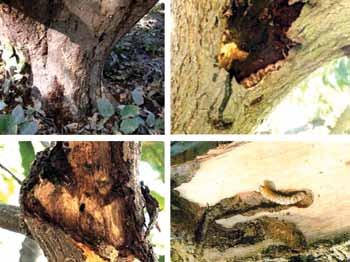
Shoot gall psylla (Apsylla cistellata)
It is a major pest of mangoes in many parts of India, particularly the Terai region of Uttar Pradesh, north Bihar, and West Bengal. This pest creates green conical galls in the leaf axis. The activity of the pest starts in August. The galls dry out after the emergence of psyllid adults in March. The females lay eggs in the midribs as well as in the lateral axis of the new leaves. Nymphs emerge from eggs during August-September and crawl to the adjacent buds to suck cell sap. As a result of feeding, the buds develop into hard conical green galls. The galls are usually seen in September-October. Consequently, there is no fruit set. There is only one generation of the pest in a year.
IPM strategy
- The galls with nymphs inside should be collected and destroyed to prevent the carryover of the pest.
- Spray with Thiomethoxam @0.5 g/litre or Dimethoate @ 1.5 ml/litre during the middle of August (Nymphal emergence time) to reduce the infestation.

Stone weevil
A female lays eggs on the epicarp of partially developed fruits or under the rind of ripening fruits. Newly emerged grubs bore through the pulp, feed on the seed coat, and later cause damage to the cotyledons. Pupation takes place inside the seed. Discolouration of the pulp adjacent to the affected portion has been observed. This is a major pest that affects the export and processing industry. There is only one generation in a year.
IPM strategy
- Sticky bands should be applied at the upper end of the tree trunk to prevent the migration of weevils to branches for egg laying on fruits during February.
- Collection of all the fallen-infested fruits and their destruction.
- Keep the tree basins clean to prevent the hiding of adult weevils.
- Spray deltamethrin (0.0025%) six weeks after the fruit set.
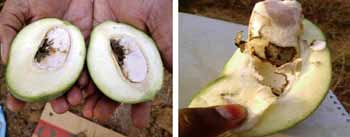
Thrips (Scirtothrips dorsalis)
Thrips have created havoc in most of the mango- growing areas of the country. Thrips caused approximately half of the fruit damage recorded in severely affected orchards. Infestation starts with the new flushes and panicle emergence during the 13th to 22nd standard meteorological weeks (Second week of March to the last week of May) in the northern plains. The larval and adult stages are the damaging stages. The damage to the mango young leaves, growing buds, inflorescence, flowers, immature and developing fruits is by lacerating and sucking the sap from the tissues. This causes silvery or brown patches on the affected parts where the plant cells have been destroyed. As a result of the damage, curling up of the leaves and wilting of the inflorescences were also recorded. In severe cases, affected fruits become rusty in appearance. This pest can damage the entire new growth, if not treated properly.
IPM strategy
- Monitor for thrips infestation by placing blue or yellow sticky traps at regular intervals.
- Neem-based pesticides control young nymphs effectively, inhibit the growth of older nymphs and reduce the egg-laying ability of adults. Spaying of neem seed kernel extract (5%) or neem oil (2%) reduces the initial stages of the thrips effectively.
- If the infestation is severe, spray with insecticides like thiamethoxam 25% WG (0.3 g/litre) or Imidacloprid 17.8% SL (0.3 ml/litre).
Fruit borer
The fruit borer affects both mesocarp as well as seeds. The young larvae scrap the epidermal tissue and the mature ones bore into the fruit and feed on the pulp. The affected fruits exude resin and black or brown rough sticky patches can be seen in the infected areas.
Management
- The spray of Lambda-Cyhalothrin 5 EC (1 ml per litre of water) at the marble stage of fruit and, if needed, repeat the spray after 15 days.
Leaf webber (Orthaga euadrusalis Walker)
This pest has become a serious and emerging problem as one of the most obnoxious pests in the northern states. Old orchards with less space between the tree canopies harbour more insects than open orchards. Its infestation begins in April and lasts until December. Initially, caterpillars feed on the leaf surface by scrapping. Later they make a web of tender shoots and leaves together and feed within them. The infestation is severe in shady conditions.
IPM strategy
- Mechanical removal of leaf webs infested by leaf Webber by leaf web removing device and burning them.
- Spraying with lambda-cyhalothrin @ 1ml/litre at 15 days interval.


Shoot borer (Chlumetia transversa Walker)
Larvae enter the mid rib of leaves and then enter into the young shoots through the growing points by tunneling downwards. They excrete their excreta through the entrance hole and the shoot becomes hollow. Larvae bore into the young shoots, resulting in the drooping of the leaves and the wilting of the shoots. Larvae also bore into the inflorescence stalk.
Management
Need based spray of lambda cyhalothrin @1 ml/litre at fortnightly intervals during the emergence of new flush.
CRISPR/Cas9 mediated genome editing of mango fruit fly, Bactrocera dorsalis
Utility of genome editing of mango fruit fly, Bactrocera dorsalis mediated by CRISPR/Cas9 was demonstrated by disrupting the white gene, spermatogenesis pathway genes such as topi, per. Editing was achieved by delivering single guide RNAs (sgRNAs) along with Cas9 protein through embryonic microinjection and by electroporation. Disruption of white gene produced greenish metallic eye color and variation in pigmentation in cephalothorasic region. This successful lead could be useful for developing male only strains by disrupting oogenesis and speramatozoa production pathway genes. This will ena b le f uture environmental release of sterile males for area wide pest management of B. dorsalis.
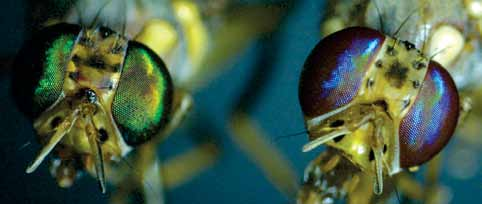
Author
H S Singh and Gundappa Baradevanal

